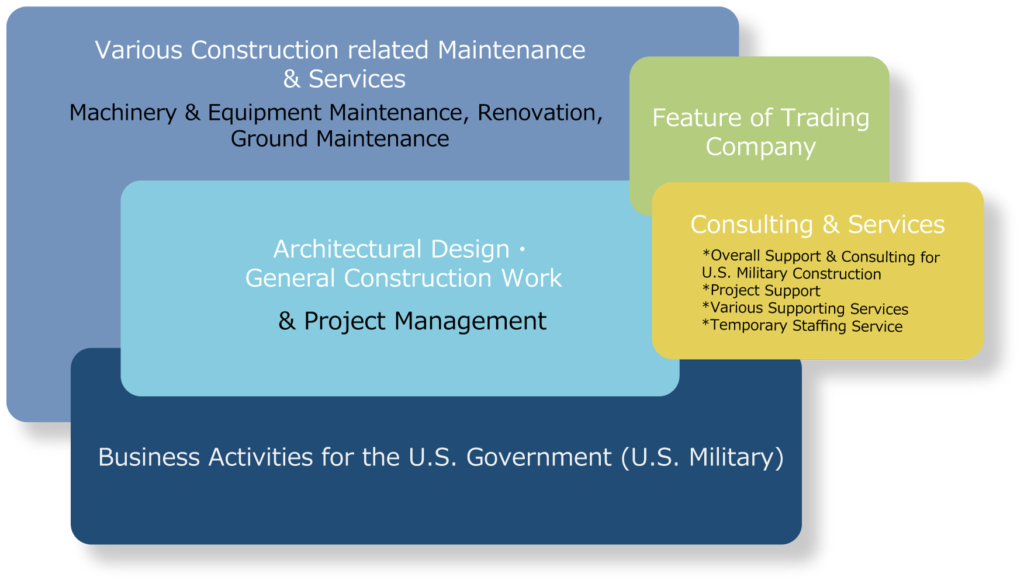Our Business Domain
There are two types of construction works on U.S. Military bases in Japan.
1. Construction work ordered by Ministry of Defense funded by the Japanese Government.
2. Construction work ordered by the U.S. Military.
For construction work ordered by the U.S. Military, contracts for various construction, electrical, equipment, and related incidental and maintenance work, as well as various services for maintaining the living environment, are executed by the U.S. Government (U.S. Department of Defense) bidding system.
Our business operations cover various supporting services, primarily construction work ordered by the U.S. Military.
In its series of business activities, our company mainly operates in Okinawa. Outside Okinawa, we provide services limited to related services (various outsourcing, consulting, and other solution services related to project management operations).

Our “Comprehensive New Entry Support Consulting and Related Services” for U.S. Military Construction
As mentioned above, our business is limited to construction projects ordered by the U.S. Military, not those ordered by Japan’s ministry of Defense. With few companies providing supporting services from the initial stage of entry to this business, we have received an increasing number of inquiries and a variety of orders in recent years.
This market is very attractive. At the same time, however, it requires a certain level of business structure.
Below explains the outline and workflow of the U.S. Military construction.
Major Differences between Japanese Domestic Construction and U.S. Military Construction
The technical capabilities of Japanese construction contractors are sufficient to carry out the U.S. Military construction work (aside from material differences such as specifications). However, each contract ordered by the U.S. Military is a contract with the U.S. Department of Defense, therefore, the rules, regulations and customs are completely different from those for the Japanese construction projects.
For Japanese construction projects, once a contract is signed, the contractors can manage the project as long as the work is in compliance with domestic laws and the delivery date and qualities are met.
For U.S. Military construction, on the other hand, the work must be approved in advance by the U.S. Military. This includes the approval of work crews and subcontractors. Therefore, it is difficult to make sudden adjustments to the work crews. This makes schedules and plans extremely important.
The construction is under the control of the U.S. Military including approval on which machinery, equipment, materials to be used, manufactures and the country of production.
It is very important to understand and comprehend drawings and specifications in English correctly. Understanding technical document in English is another hurdle to overcome. Apart from technical and construction skills, the main difference between Japanese construction project and U.S. Military construction is that there are many restrictions on the environment itself in which construction work can proceed for the U.S. Military construction works.
U.S. Military Construction Flow
For companies considering entering the U.S. Military Construction market, we recommend gathering as much detailed information as possible and formulate a concrete image of the market at the early stage of entry.
In recent years, we have encountered many companies that entered the market, obtained entity IDs (as explained below) through service providers adverting “Quick entry to the U.S. Military construction market” only to find themselves lost on what to do next.
For this reason, we highly recommend gathering accurate information in advance, and considering it thoroughly before moving forward.
After completing the NCAGE code and SAM registration, you will be able to obtain bidding information and participate in bidding.
2,Select the projects you wish to bid on from the bidding information published on the U.S. Department of Defense’s Internet site and register to participate in Site Visit.
3,Basic information such as specifications, deadlines, and laws are understood from drawings and bidding conditions written in English (if it is a construction project), and the construction price is calculated and submitted together with the designated bid documents.
(1) Invitation for Bid (IFB): The lowest bidder will be selected on the date of bid opening; at which time the contract will be awarded if the bidder obtains the contract rights and passes the contract practice and U. S. Military review.
(2) Request for Proposal (RFP): Upon submission of a written bid that meets the bidding requirements, you will receive a bid result several months later.
Unlike IFB, the documents required for the review have already been submitted, so once the decision notice is received, the subsequent contract award is greatly reduced.
Although there are other types of bidding methods, contract opportunities can be divided into two major categories as mentioned above.
4,For U.S. Military Construction project, a team with U.S. military-approved qualified personnel such as PM, QC, SSHO, etc. and IT operator to share schedule management with U.S. Military through a designated project management software is set up, and on-site construction activities are carried out.
5,In addition, after construction has begun, contractor must obtain approval for materials to be used, entry permit of workers and vehicles to U.S. bases through a series of preliminary meetings.
As such, there are checkpoints throughout the construction process, and the work is carried out undergoing inspections at any time during the process, various tasks involved in construction is very complicated, and require experience and expertise. We have established a system that allows us to participate in the planning and development of a failure-free plan for companies considering entering the market.
